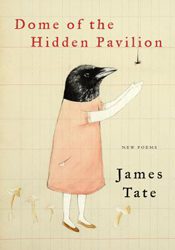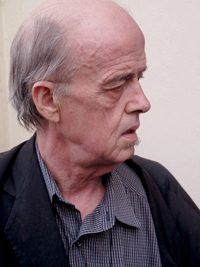
I don’t think James Tate wanted to write poems any stranger than the world actually is, the world where your father can be shot down from the sky one day. Tate will be remembered as a surrealist, but I think of him as a refresher of the real—by spending time inside of his odd worlds, we can then look up and see the oddness of our own. In his final collection, Dome of the Hidden Pavilion, he provides 108 more such mirrors.
Reading his later books—this new one included—you get the sense that Tate stopped being guided by usual standards of poetic quality, and instead became obsessed with cataloguing his imagination. The word “formula” does not have a happy relationship to poetry, but Tate seems to have found one that allowed him to explore his mental terrain in the fullest possible way.
In Tate’s later poems, a man—typically friendly, possibly lonely—wanders into a crazy situation, and we, as readers, watch it unfold. The tone is casual enough that the craziness doesn’t smack us in the face, but instead becomes the new normal. Using this approach, Tate created a rich tapestry of inviting, small-town strangeness. As in fairy tales, there are archetypal elements—walks in the woods, distant wars, animals, mysterious phone calls, to name a few—that are repeated but rearranged to evoke new scenarios.
There’s a lot to like about these poems: their comic timing, their wild imagination, their darkness. But what made Tate unique was his persistence. He found a home in a style and never left it. Beginning with the late 1990s, all of his work pretty much looks and acts the same—prose poems that tell stories. He wrote hundreds of them. This sort of repetition is often frowned upon in poetry, as it can indicate a lack of evolution. To me, it’s what’s most fascinating about Tate’s career.
In his 2006 interview with the Paris Review, Tate said of his prose poems: “When I was younger I might have had some prejudice against strict narrative, thinking it was some limited kind of endeavor. And then once I stumbled into these I kept thinking, Well, the challenge is to show that it’s not limited, that you can keep expanding what you can do within that form.” The question, then, is whether or not Dome of the Hidden Pavilion represents a continued expansion. Is the form unlimited, as he claims it is?
The new book does have a new makeup. The poems take an amplified interest in the meeting of the personal and political, illness (both mental and physical), and the awareness of a looming death. Tate is also more focused than ever on the interplay between imagination and reality. In “Toy Soldiers,” the speaker has a house full of toy soldiers. The catch is that some are real, not toys, and the speaker cannot tell which are which. In the heartbreaking final poem, “Plastic Story,” the speaker is actually suffocated by a piece of plastic he thought he was only dreaming about.
Tate’s empathy for the small and strange—the rabbits, the bees, the soul of a mouse who dies in a practical joke—is intact and wonderful. As usual, the poems are not limited by intention. They manage to be accessible and moving without pandering because, as per Robert Frost’s dictum, they ride on their own melting, finding their way as they go. Some of Tate’s best prose poems are in this collection.
 But something else also sneaks in at the edges—a kind of resignation, especially in the endings. Four poems in the collection end on the phrase, “I don’t know.” Others end with similarly blank statements: “Oh,” “Oh, that makes sense,” “I don’t understand,” “I know.” Compared to Tate’s previous books, Dome of the Hidden Pavilion contains somewhat fewer poems that end on zingers or tangents, and more that bow out with little nods. In general, this serves to soften the impact of the work.
But something else also sneaks in at the edges—a kind of resignation, especially in the endings. Four poems in the collection end on the phrase, “I don’t know.” Others end with similarly blank statements: “Oh,” “Oh, that makes sense,” “I don’t understand,” “I know.” Compared to Tate’s previous books, Dome of the Hidden Pavilion contains somewhat fewer poems that end on zingers or tangents, and more that bow out with little nods. In general, this serves to soften the impact of the work.
It may be Tate just enjoying the quieter side of anti-endings. Or it may be a hint of something more: a shift away from play and towards somberness. In Dome of the Hidden Pavilion, you do not see a poet transcending or reinventing the form; you see a poet coming to terms with his cage.
If that sounds disappointing, it isn’t. Reading Tate twist inside of the form is a phenomenal pleasure. And as I see him do it again in his last book, I begin to believe there is wisdom in the persistence. There is this way we all choose shapes for our lives, and then there is this sad, funny paradox of how we simultaneously accept those shapes and bang and bang and bang against them. Maybe you cannot escape the box, but if you try you can stretch it.
In his effort to surprise himself at every turn and keep the form fresh, James Tate stretched the minds of readers, and his voice will be missed. “Manual for Self-Improvement” is one of the poems in the collection that can be read as a kind of goodbye. Here is how it ends:
… I was in a strange
land. There was a bamboo curtain behind which sat a little
mouse. “Hello, friend,” he said. I looked again. He wasn’t
there. And, then, neither was I.




